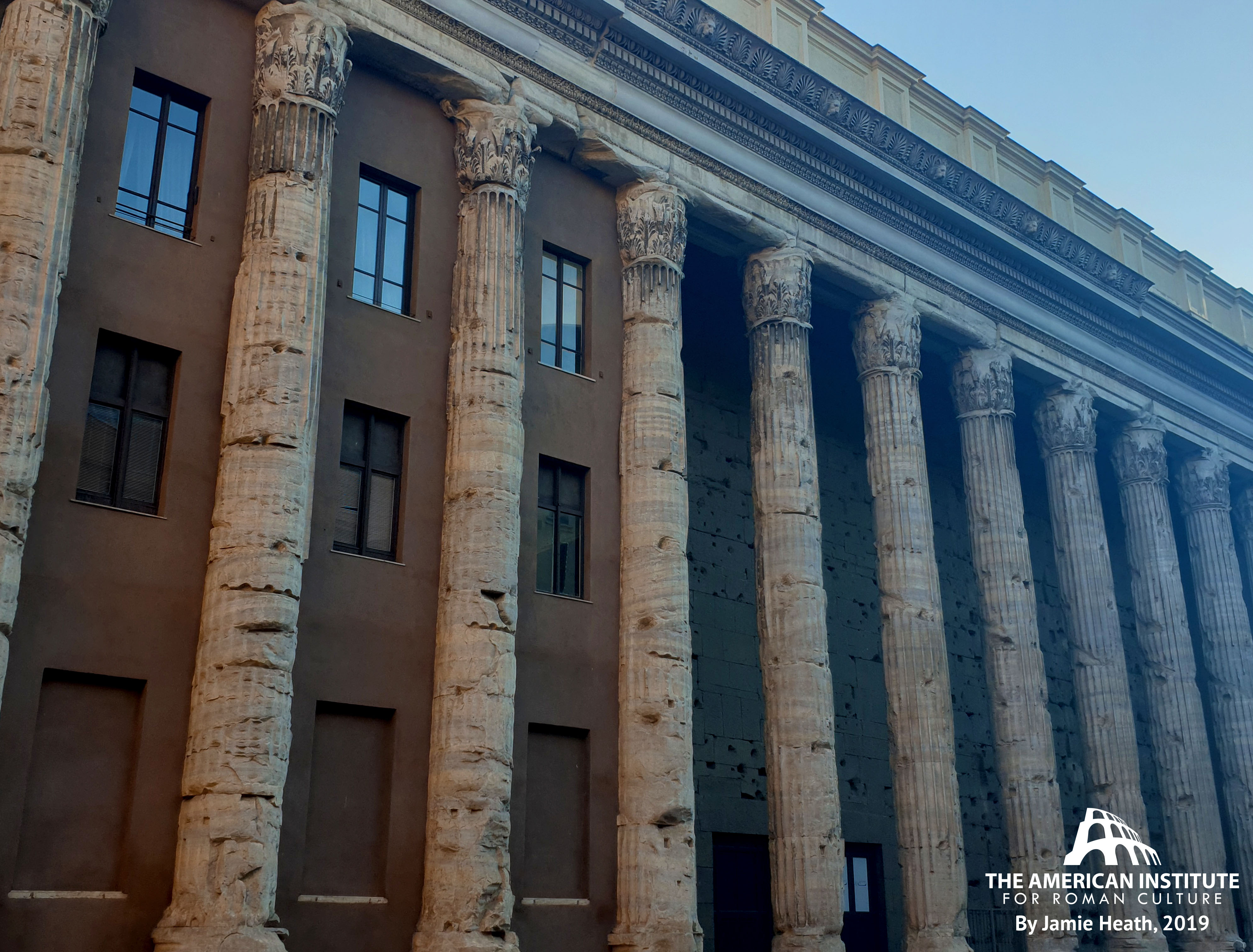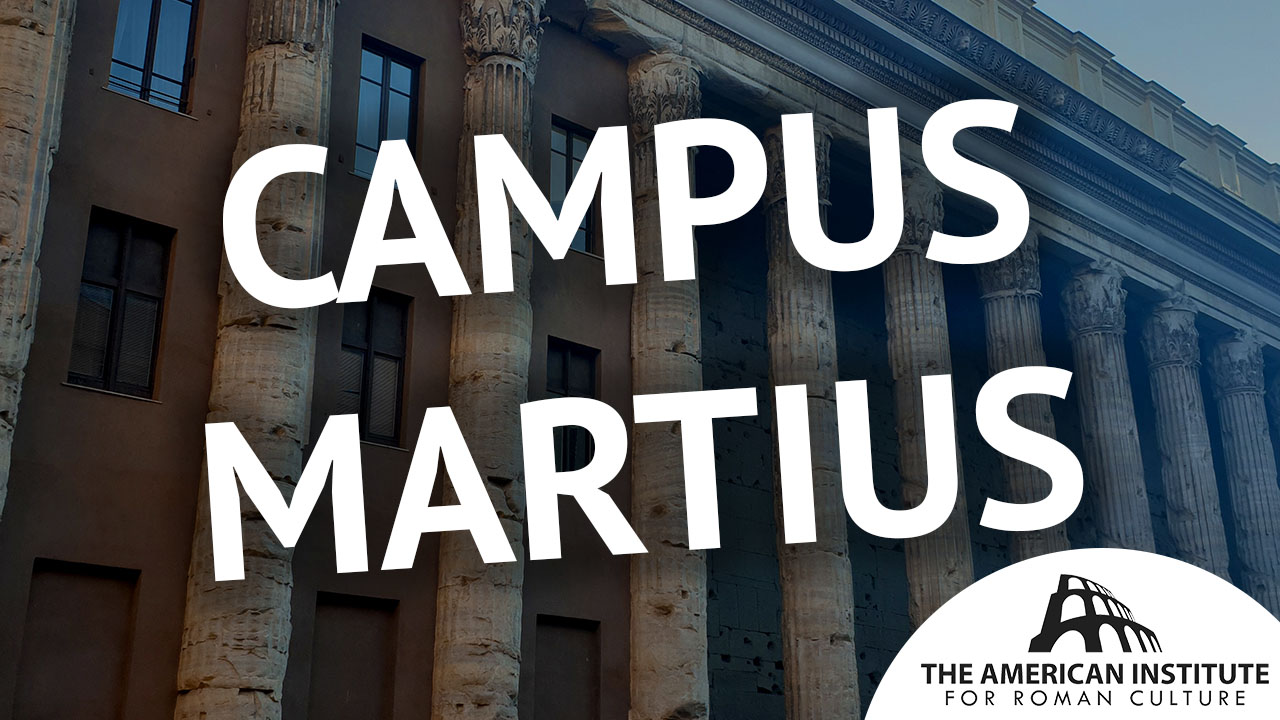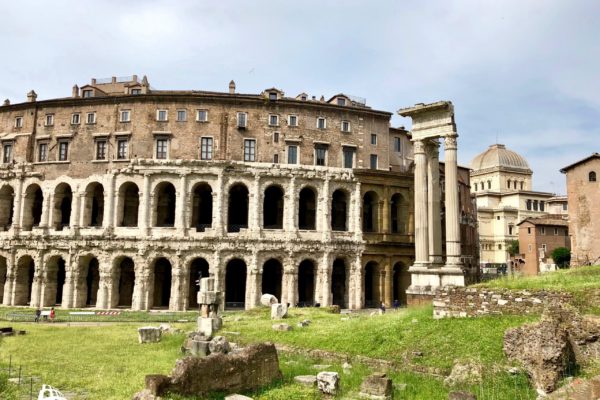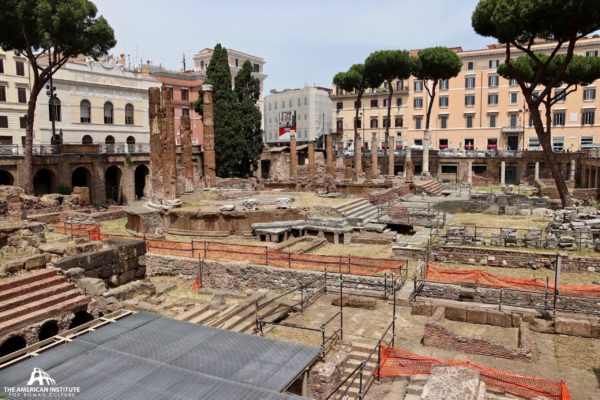Start with our video overview:
The Campus Martius is the massive flood plain defined by the massive curve of the Tiber River that stretches from above Piazza del Popolo to beyond the Tiber Island, roughly over a square mile. This flood plain was a place of exercise and military training in the regal period, according to tradition, the property of the Tarquin rulers. Once expelled, the land became ager publicus (public land) and dedicated to Mars (Livy 2.5.2). In the 5CBC, the most important construction was the Villa Publica with the component of the Saepta for voting. Nearby, there was the Altar of Mars, although its original location has never been identified. An altar to the Pluto and Persephone (with a circus) along the Via Giulia and a temple of Apollo at the campus’ southernmost end were other 5C places of worship.
Republican victory temples began to appear south of the saepta (today’s Largo Argentina) and along the Circus Flaminius (220 BC).
The Theater of Pompey complex created a new paradigm in Rome in terms of the scale that victorious generals now built (55 BC). Caesar planning to supersede Pompey’s magnificent theater and porticoes, lined with fountains, gardens and statuary, actually attempted to pass legislation to reroute the Tiber so that the flooding would cease (Cicero Att. 13.33.4). His proposal never came to fruition.
Augustus saw to the creation of his Mausoleum and public parks (Suetonius, Aug. 100.3-4). Nearby the Senate vowed the Ara Pacis to be constructed along the Via Lata. Augustus located his horologium (sun dial) in its vicinity. He also constructed a stadium in wood.
Agrippa brought water to the Campus Martius through the Aqua Virgo for fountains and his baths, the first large scale thermae and stagnum for the public (Dio, History, 54.29.4). (later joined by the. Baths of Nero). Agrippa completed Caesar’s saepta project (Dio, History, 53.23.1-2) and built the diribitorium (completed by Augustus, as per Dio, History 55.8.4). He constructed the first Pantheon, Basilica of Neptune, and Porticus Vipsania. The Augustan era Campus Martius is summarized in the famous descriptive passage of Strabo, Geography, 5.3.8.
Fires and floods periodically struck the floodplain over the centuries. The fire of AD 80 led to the rebuilding of the stadium, Pantheon, among many monuments. Domitian also created the Porticus Divorum, Odeon, and rebuilt the Temple of Isis and Serapis. After the fire of 110, Hadrian rebuilt the Pantheon, Saepta, and Basilica of Neptune. He also added the Temple of Matidia and of Hadrian. Nearby were added many sites of the cremation of family members, as well as the Column of Antoninus Pius, Temple of Marcus Aurelius, and Column of Marcus Aurelius.
By the 4C-7C the population and activities in the city were diminishing. Flooding, which was always an issue, seems to have been exacerbated as we note from the ground level of the Ara Pacis, already meters below the street level in the Hadrianic era, became totally buried in late antiquity. Continual occupation in this area was fully developed in the Renaissance and Baroque periods (and why we refer to the Campus Martius today as the “historic center” or centro storicio). Businesses and housing thrived, through on a more modest, local scale, reutilizing whatever ancient monuments were still standing (e.g., housing constructed on the stadium, theaters). The topography changed, with “monti” formed through the dumping of refuse and building material (e.g., Monti Cenci, Montecitorio) in medieval period. Still many monuments persisted in various forms. The Pantheon became a church in the 7C. The rotunda hall of the Baths of Agrippa were incorporated into buildings. Temple A of Largo Argentina became a church. The Temple of Hadrian became the Chamber of Commerce. The Mausoleum of Augustus became a fortification, garden enclosure, bull fighting arena, and opera house, only to be revealed again as a monument, stripped of the later constructions, in the Fascist era. Flooding ceased to be an issue with the construction in the 1870s and the late 19C, early 20C urban renewal projects revealed many ancient sites throughout the Campus Martius.
Explore further:
Campus Martius: the level ground between the slopes of the Capitoline, the Quirinal, and the Pincian hills, and the Tiber. This term varied somewhat in its signification; for, while originally and in its widest sense it embraced all this district, other names for small sections seem to have come into use later. Thus as early as the fifth century B.C. the south portion of the plain was probably known as Prata Flaminia, and campus Martius was the ordinary designation of what lay beyond. After Augustus had divided the city into fourteen regions, the name campus Martius was restricted to that portion of Region IX (circus Flaminius) which lay west of the via Lata, the modern Corso; and here again there seems to have been a further distinction, for a cippus (CIL VI.874) found near the Pantheon indicates that the campus Martius of the time of Augustus was divided into two parts — the district between the cippus and the circus Flaminius, which had been more or less built over, and the open meadow to the north, the campus proper; cf. ib. 31189; BC 1883, 11‑12.
The campus Martius covered an area of about 250 hectares (600 acres), extending a little more than two kilometres north and south from the Capitoline to the Porta Flaminia, and a little less than two kilometres p92 east and west in its widest part, between the Quirinal and the river. It was low, from 10 to 15 metres above the level of the sea in antiquity (13 to 20 now), and from 3 to 8 above that of the Tiber, and of course subject to frequent inundations. It contained several swamps or ponds, as well as streams, the largest of which, the Petronia Amnis (q.v.), which formed the limit of the city auspices (AR 1909, 67‑70) came from a spring on the Quirinal, called the Cati fons, and flowed into the largest swamp, the palus Caprae or Capreae, where were afterwards the pool and baths of Agrippa. In the north-west part of the campus, near the great bend in the river, there were hot springs, probably sulphurous, and other traces of volcanic action. Some small part at least was wooded, for we know of two groves, Aesculetum and Lucus Petelinus
The campus Martius, frequently called campus alone (Reference Latin Library Liv. XL.52.4; Cic. Cat. II.1.1; Iuv. II.132; Hor. Carm. III.1.11; Ov. Fast. II.860; iii.519), derived its name from the cult of Mars, or from the fact that it was consecrated to Mars. According to one form of the tradition it was private property of the Tarquins, and after their expulsion became state land, and was dedicated to Mars (Latin Lbrary: Liv. II.5: ager Tarquiniorum qui inter urbem ac Tiberim fuit consecratus Marti Martius deinde campus fuit; populus Romanus agrum Marti suo consecrat; Schol. Iuv. I.132: hic enim ager Tarquini superbi fuit et pro illius fuga Marti consecratus dictus est Martius campus; τοῦ δ’ Ἀρείου πεδίου τὸ ἥδιστον ἐκέκτητο Ταρκύνιος καὶ τοῦτο τῷ θεῷ καθιέρωσαν); according to another Dionys. V.13, it had been consecrated to Mars at an earlier period and afterwards appropriated by Tarquin. This view is supported by the existence of an Ara Martis (q.v.), situated probably east of the Pantheon in the Via del Seminario, which, according to Festus, was mentioned in a law of Numa and therefore dated from the early regal period. The note of Servius:: mos fuerat ut viris fortibus sive regibus pro honore daretur aliqua publici agri particula ut habuit Tarquinius Superbus in campo Martio) may be reconciled with either form of this tradition, but the first was probably the more generally accepted.
Another tradition concerning the public ownership of part or all of this district is apparently embodied in certain references to the gift of a Campus Tiberinus (q.v.) or Martius to the state by a Vestal virgin, Gaia Taracia or Fufetia: invenitur statua decreta et Taraciae Gaiae sive Fufetiae virgini Vestali ut poneretur ubi vellet . . . meritum eius ipsis ponam annalium verbis: quod campum Tiberinum gratificata esset populo; ; cf. HJ 475; Gell. VII.7.4). As Gellius alone identifies campus Tiberinus and campus Martius, much uncertainty is attached to the whole matter (Gilb. II.112‑113; RE VII.480‑483; Mommsen, RF ii.7‑8; Mitt. 1921‑2, 23‑28).
At any rate the campus belonged to the state from the beginning of the republic, and we are told (Oros. V.18.27) that Sulla, under the financial p93 pressure of the impending war with Mithridates, was the first to sell any part of this public domain to private owners, although the name prata Flaminia seems to indicate some private ownership at a very early date. It is probable, however, that these prata had become public property but retained their original name. There are further indications of the encroachment by individuals on the boundaries of the campus in the first or possibly the second century B.C., such as the suburb called Aemiliana (q.v., just outside the Porta Carmentalis; and perhaps a villa and gardens of the elder Scipio (Latin Library: Phil. II.109; ἐς τὸ προάστειον ἀπάντησας). Private houses did not begin to multiply to any extent (cf. Cic. ad Att. XIII.33) before the time of the empire, but they became fairly numerous, for the Regionary Catalogue lists 2777 insulae and 140 domus in Region IX.
From the beginning the campus Martius was used as pasture for sheep (Schol. Iuv. VI.528) and horsesl was cultivated for grain (cf. the story of Tarquin’s grain); and furnished space for the athletic and military exercises of the Roman youth (Dionys. loc. cit.; Latin Library: Hor. Carm. III.7.25‑27; Veget. de re mil. i.10). It was entirely outside the pomerium during the republic and probably remained so down to the reign of Claudius . By the time of Hadrian the pomerium had been extended to include the prata Flaminia, but the campus Martius in its narrower sense was not included until the wall of Aurelian was built. Because it was public property and outside the pomerium, the campus was used as the place of assembly for the citizens (Latin Library: Liv. I.44;), in their military capacity as an army and in their civil capacity as the comitia centuriata. The enclosed space in which this comitia voted came to be known as ovile or saepta (q.v.; Serv. Ecl. I.33 et al.). Audience was given here to foreign ambassadors who could not enter the city (Liv. Latin library XXX.21.12; XXXIII.24.5), and foreign cults were domiciled in temples erected here.
We know certainly of only threeº other cult centres besides that of Mars in the campus Martius before the Punic wars — the ara Ditis et-Proserpinae in Tarento, the Apollinare, an altar or grove, and the temple of Apollo which was built in 431 B.C., and the temple of Bellona built in 296 B.C. Between 231 and the battle of Actium at least fifteen other temples were erected, and more during the next century. The construction of the circus Flaminius in 221 B.C. marked an epoch in the history of the southern part of the campus, but there was no public building of any note in the campus Martius proper before the end of the republic, when Pompeius built the first stone theatre in Rome in 55 B.C. Caesar conceived the idea of changing the course of the Tiber by digging a new channel on the west of the Janiculum, and of building over all the plain between that hill and those on the east side of the city (Cic. ad Att. XIII.33). The river bed was not changed; but Augustus and his coadjutors began the construction of all kinds of public buildings, with p94 the result that, by the time of the Antonines, all of this district except the north-west section, which was still kept open, was covered with many of the most wonderful structures in Rome, circuses, theatres, porticoes, baths, columns, obelisks, mausolea, temples, etc. The remarkable appearance of the campus even before the death of Augustus is described by Strabo in a well-known passage, where, however, the traditional text requires rearrangement (A. W. Buren, Ann. Brit. Sch. at Athens, xxii.1916‑18, 48‑50, following P. Meyer, Straboniana, 20).
There is some doubt as to whether the murder of Valentinian III in 455 A.D. occurred in the Campus Martius proper, or in the campus Martius, or drill ground (the words are frequently used in this sense nowadays both in France and Italy) attached to the imperial villa ‘ad duas lauros’ beyond the third milestone of the via Labicana (Johannes Ant. fr. 85, p126; Chron. Min. I.162, 303, 490; ii.86, 157, 186; iii.422). In the former case, we should have to suppose the existence in the fifth century A.D. of another locality in the campus Martius, bearing the same name ‘ad duas lauros,’ and the latter appears to be preferable (BCr 1879, 76; Studi e Documenti xvii. (1896), 47, 48; BC 1906, 74‑77; T x.390; Mem. AP i.3 (1927) 158; contrast.
With the decline of the city after the barbarian invasions, the rapidly dwindling population gradually abandoned the surrounding hills and was concentrated in the campus Martius, which contained the main part of Rome until the new developments in the nineteenth century.
For the history of the campus Martius, its development and monuments, see HJ 472‑506 (historical development), 507‑621 (monuments); Pl. 339‑392; LR 442‑511; F. Lohr, Das Marsfeld, Gütersloh, 1909; AR 1909, 67‑82).
This content is brought to you by The American Institute for Roman Culture, a 501(C)3 US Non-Profit Organization.
Please support our mission to aid learning and understanding of ancient Rome through free-to-access content by donating today.
Cite This Page
Cite this page as: Darius Arya, The American Institute for Roman Culture, “Campus Martius” Ancient Rome Live. Last modified 11/11/2019. https://ancientromelive.org/campus-martius/
License
Created by The American Institute of Roman Culture, published on 11/11/2019 under the following license: Creative Commons: Attribution-NonCommercial-ShareAlike. This license lets others remix, tweak, and build upon this content non-commercially, as long as they credit the author and license their new creations under the identical terms. Please note that content linked from this page may have different licensing terms.





